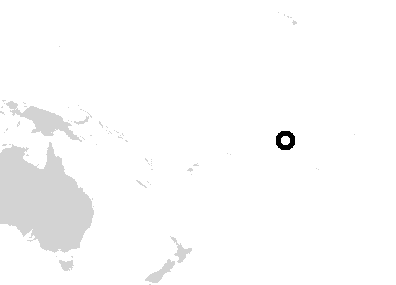
| www.CuriousTaxonomy.net |
|
The Flood in World Myth and Folklore
Pacific |
| © 2021 Mark Isaak |

The rain god Aokeu ("Red Circle" for the red clay he washes around the island), who was lowly born of the drippings from stalactites, disputed with the ocean god Ake to see which was more powerful. Ake summoned help from the wind god Raka and his twin children Tikokura, who is seen in the line of curling billows which break over reefs, and Tane-ere-tue, who manifests in storm waves. They attacked the coast, reaching the height of the Makatea, a raised barrier reef plateau surrounding the island, hundreds of feet high. Proof of their deeds may be seen in seashells embedded in high rocks. Meanwhile, Aokeu caused five days and nights of rain, washing the red clay and small stones into the ocean and carving deep valleys. Rangi, the people's first chief, had been forewarned and led his people to Rangimotia, the central peak. Soon water covered everything except a long narrow strip of soil, and the tide continued rising. Rangi waded through water up to his chin to reach the temple of the supreme god Rongo, and appealed to him. Rongo looked at the war of the waters and cried "Enough!" The sea subsided and the rain stopped, leaving the island with its present landscape. Aokeu was judged the victor, because the sea had been stopped by the rocky heights, but but the rains flowed far into the ocean, carrying red clay to mark their progress.
Frazer, 1919, 246; Vitaliano, 1973, 168.

Ina-moe-aitu ("Ina who had a Divine Lover") lived at Tamarua. She loved to bathe in a nearby slow stream which had many eels. One large eel regularly rubbed against her as she swam. At first this startled her, but she soon became accustomed to its touch. One day this eel assumed the form of a handsome youth and said to her, "I am Tuna, god of the fresh-water eels and their protector. Your beauty has lured me from my home to win your love." She gave her love, and he would thereafter come and assume human form long enough to visit with her.
Some time later he said to Ina, "We must part. But I will grant you a boon. Tomorrow a great rain will come and flood the valley, but do not fear it, for it is merely the means by which I may approach your house in the form of an eel. When I lay my head upon your doorstep, chop it off and bury it. Then watch the spot to see what comes from it."
That night it rained heavily, and Ina rose to find the waters nearing her hut. The eel came and placed his head on her wooden doorstep, and Ina, remembering Tuna's instructions, cut off the head and buried it. Immediately the rains stopped and the water receded.
Ina daily visited the spot where the head was buried and, after many days, saw two shoots coming from the soil. These were the two varieties of coconuts which now grow on the island. When the nuts are husked, one may still see the eyes and mouth of Ina's lover.
Johannes C. Andersen, Myths and Legends of the Polynesians (London: George G. Harrap, 1928), 258-260.
